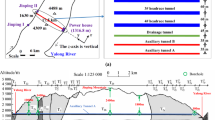Abstract
The seven long tunnels of Jinping II hydropower station are deeply buried. The width and evolution characteristics of excavation damaged zone (EDZ) are the key problem to the design of tunnels excavation and supports. In order to study this problem, several specific experimental tunnels with different overburden and geometric sizes were excavated at this site. Digital borehole camera, sliding micrometer, cross-hole acoustic wave equipment and acoustic emission apparatus were adopted. This paper introduced the comprehensive in situ experimental methods through pre-installed facilities and pre-drilled boreholes. Typical properties of the surrounding rock mass, including cracks, deformation, elastic wave and micro fractures, were measured during the whole process of the tunnel excavation. The width and characteristics of formation and evolution of tunnels EDZ were analyzed under different construction methods involving of TBM and drilling and blasting, the test tunnels were excavated by full-face or two benches. The relationships between EDZ and tunnel geometry sizes, overburden and excavation method were described as well. The results will not only contribute a great deal to the analysis of rock mass behavior in deeply buried rock mass, but also provide direct data for support design and rockburst prediction.
Similar content being viewed by others
References
Aston T R C, Gilby J L, Yue C M K. 2A comparison of rock mass disturbance in TBM and drill and blast drivages at the Donkin Mine, Nova Scotia. Int J Min Geol Eng, 1988, 6: 147–162
Pan P Z, Feng X T, Hudson J A. Study of failure and scale effects in rocks under uniaxial compression using 3D cellular automata. Int J Rock Mech Min Sci, 2009, 46(4): 647–685
Zhang C G, Wang J F, Zhao J H. Unified solutions for stresses and displacements around circular tunnels using the Unified Strength Theory. Sci China Tech Sci, 2010, 53(6): 1694–1699
Liu Y R, Chang Q, Yang Q. Fracture analysis of rock mass based on 3-D nonlinear Finite Element Method. Sci China Tech Sci, 2011, 54(3): 556–564
Zhang L Y, Mao X B, Lu A H. Experimental study on the mechanical properties of rocks at high temperature. Sci China Tech Sci, 2009, 53(3): 641–646
Kwon S, Lee C S, Cho S J, et al. An investigation of the excavation damaged zone at the KAERI underground research tunnel. Tunn Undergr Space Tech, 2009, 24(1): 1–13
Martino J B, Chandler N A. Excavation-induced damage studies at the underground research laboratory. Int J Rock Mech Min Sci, 2004, 41(8): 1413–1426
Read R S. 20 years of excavation response studies at AECL’s underground research laboratory. Int J Rock Mech Min Sci, 2004, 41(8): 1251–1275
Cai M, Kaiser P K, Tasaka Y, et al. Generalized crack initiation and crack damage stress thresholds of brittle rock masses near underground excavations. Int J Rock Mech Min Sci, 2004, 41(5): 833–847
Egger P. Study of excavation induced rock damage at the grimsel underground rock laboratory. Nucl Eng Ng Des, 1989, 116: 11–19
Sato T, Kikuchi T, Sugihara K. In-situ experiments on an excavation disturbed zone induced by mechanical excavation in Neogene sedimentary rock at Tono mine, central Japan. Eng Geology, 2000, 56: 97–108
Yan P, Lu W B, Shan Y G. Detecting and study of blasting excavationinduced damage of deep tunnel and its characters (in Chinese). Chin J Rock Mech Eng, 2009, 28(8): 1552–1561
Stephen D, Falls l, Young R P. Acoustic emission and ultrasonic-velocity methods used to characterize the excavation disturbance associated with deep tunnels in hard rock. Tectonophysics, 1998, 289: 1–15
Kelsall P C, Case J B, Chabannes C R. Evaluation of excavation-induced changes in rock permeability. Int J Rock Mech Min Sci, 1984, 21(3): 123–135
Wu S Y, Shen M B, Wang J. Jinping hydropower project: main technical issues on engineering geology and rock mechanics. Bull Eng Geol Environ, 2010, 69: 325–332
Williamsa J H. Carole D. Johnson, Acoustic and optical borehole-wall imaging for fractured-rock aquifer studies. J Appl Geophys, 2004, 55: 151–159
Wang C Y, Law T K, Ge X R. Borehole camera technology and its application in the three gorges project, Proceedings of the 55th Canadian Geotechnical and 3rd Joint IAH-CNC and CGS groundwater specialty conferences, Niagara Falls, Ontario, 2002. 601–618
Author information
Authors and Affiliations
Corresponding author
Rights and permissions
About this article
Cite this article
Li, S., Feng, X., Li, Z. et al. In situ experiments on width and evolution characteristics of excavation damaged zone in deeply buried tunnels. Sci. China Technol. Sci. 54 (Suppl 1), 167–174 (2011). https://doi.org/10.1007/s11431-011-4637-0
Received:
Accepted:
Published:
Issue Date:
DOI: https://doi.org/10.1007/s11431-011-4637-0




